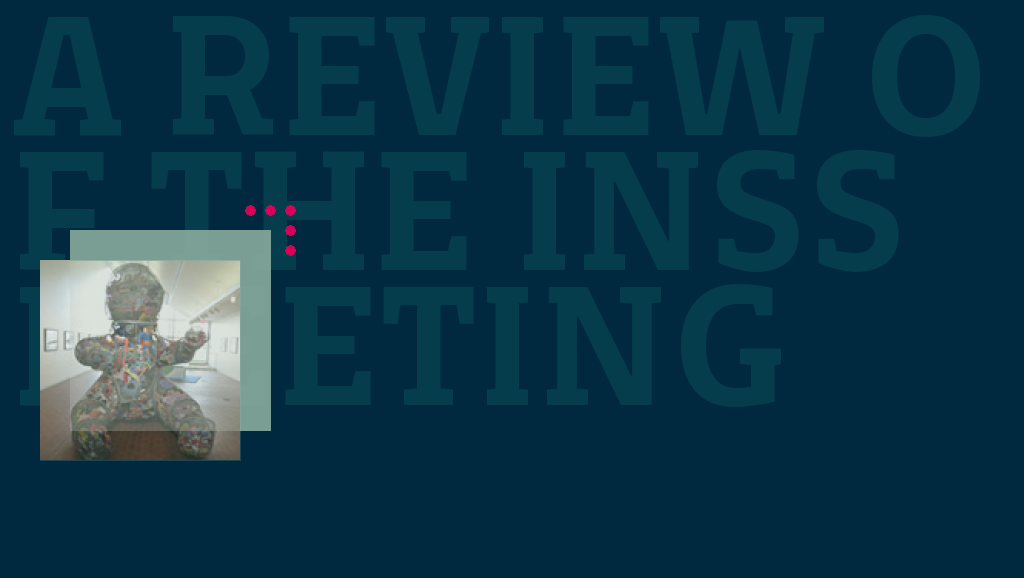As many readers will know, last weekend I attended the Integrated Network for Social Sustainability (INSS) meeting in Charlotte, North Carolina. I was fortunate enough to have been selected to present a poster as part of the Saturday afternoon poster session. The poster can be seen here via the Bassetti Foundation Flikr account, alongside many other photos of the event.
Further details of the poster and the full abstract are available here.
The poster event was well attended, with an array of presenters from many disciplines addressing issues as broad as earthquake risk analysis, teaching sustainability in civil engineering, promoting ethics, culture and community based research and a very interesting permacuture collective run with the aid of students and staff of Ball state University.
The poster session sat within a large and varied program that included an art exhibition called Sustain me Baby, that included a giant model baby filled with plastic toy trash and photos of dead baby albatrosses, and various installations placed throughout the city representing the problem of plastic waste. See the Keeping Watch website for further details.
The meeting started on Friday with a tour of sustainable manufacturing, that included a visit to a brick works owned and operated by Boral. The Boral website goes into the detail of their sustainable design frame, but the thing I found most interesting about the factory was the fuel used to heat the kiln.
Boral buy waste sawdust from local saw mills, have an in-house grinding and drying process for the dust that they then use as fuel for the kiln. This has brought costs down dramatically as well as providing a market and use for what is essentially a waste product.
The tour was followed by a dinner presentation about aquaponics. This is a system for growing vegetables that relies on using a fish pond and a series of pipes to produce large volumes of vegetables in a relatively small area. The plants grow in pipes fed by the pond water, while the fish provide the nutrients through their excrement. 90% of the water is reused, as the plants remove the nutrients as the water passes so it can be pumped back into the pond in a continuous circuit.
The presentation was given by local architect and entrepreneur Ron Morgan with his business partner Sam Fleming. Morgan has a project part based in Haiti and part in North Carolina, and believes that the system can be used in places where people do not have access to fresh vegetables for any reason. Read this news article in which he explains the project. The system is extremely efficient, can be self contained in a shipping container for example and is extremely mobile, allowing flexibility in difficult operating areas. Interested readers can watch this video of Fleming explaining the system for a better idea of how it functions.
The conference Keynote Speaker was Julian Agyeman. Readers should take a look at his website for a full description of his work, as it is broad in content and immense in scale.
This was a hard hitting delivery, in which he outlined his concept of ‘just sustainabilities’ and argued that “integrating social needs and welfare, offers us a more ‘just,’ rounded and equity-focused definition of sustainability and sustainable development, while not negating the very real environmental threats we face” (taken from conference notes).
His focus on social justice led to a call to read sustainability from a broader standpoint, and asked some questions and raised some issues about consumption and justice that some here in the US might have difficulty reconciling.
Much of the meeting was spent divided into working groups. Each group had different goals and objectives, and reported to the conference via a panel session. Internal communication, definition, expanding and promoting the network and maximizing reach using technology were some of the topics covered, and each delivery session presented a wealth of ideas and approaches. I participated in a working group looking at the adoption of different means of communication to involve a broader general public in the debate and another that tried to define goals and objectives for the network.
Saturday also included a series of case study presentations, with representatives from SMART CN Project, the National Academy of Engineering, and Habitat for Humanity presenting their work. The day closed with a panel discussion entitled Art, Manufacturing, Sustainability, that addressed many issues including several that we would find close to the Bassetti Foundation’s Innovating With Beauty project that began in San Francisco last year.
Sunday started with presentations from virtual attendees, demonstrating both the possibilities and problems that virtual attendance offers and poses. After another session of working group reporting came a session on network engagement tools, before assessment and adjournment.
On a personal note I would like to add that this was an extremely well run and enjoyable conference. A broad range of participants (academic and non, senior and junior, young and “mature”) led to a great deal of conversation and mixing of diverse groups. We do not often find engineers and anthropologists sharing panels with public utilities and friendship garden representatives, and it is this type of interdisciplinary debate that we at the Foundation have been promoting for so long.
I would like to congratulate the organizers and participants on behalf of the foundation, wish them all well and look forward to continuing our involvement.
Some photos (also in Flickr):
—————-
















